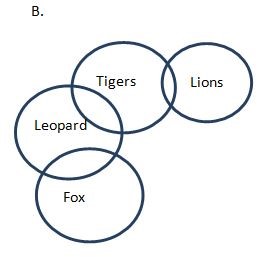Question
Statements: Some tigers are lions.
No lion is a leopard. Some leopards are Fox. Conclusions:I. No leopard is a tiger. II. Some tigers are leopards. In each of the questions below are given three statements followed by three conclusions numbered I and II. You have to take the given statements to be true even if they seem to be at variance with commonly known facts. Read all the conclusions and then decide which of given conclusions logically follows from the given statements disregarding commonly known facts. Give answerSolution
I + E = O, Hence, neither conclusion I nor II will follow. However, Conclusion I and II make a complementary pair, hence, either conclusion I or II will follow. ALTERNATE METHOD: All possible cases: 

 In case A, no leopard is a tiger and in case B & C some tigers are leopard. Thus, either of them is true.
In case A, no leopard is a tiger and in case B & C some tigers are leopard. Thus, either of them is true.
Which Indian bank became a signatory (Nov 2024) to the Partnership for Carbon Accounting Financials (PCAF)?
Which country's central bank signed a pact with NPCI International Payments Limited (NIPL) to develop a UPI-like instant payment system?
Consider the following statements with respect to India’s outward FDI.
I.According to the data provided by the Reserve Bank of India, India’s...
Who has been appointed Deputy National Security Adviser to handle internal affairs?
- On whose 1009th birth anniversary was 1 commemorative postage stamp released by the Department of Posts in March 2025?
Which region remains the most affected by hunger, as identified in the 2025 GHI?
In the Namo Drone Didi Scheme, which committee is responsible for monitoring operations and ensuring the quality of services provided through drones?
What significant achievement has the Visakhapatnam Port recently accomplished according to the Container Port Performance Index 2023?
Who has won the Men’s Ballon d’Or Award for the year 2021?
What was the objective of the two-day comprehensive Coastal Security Exercise Sagar Kavach 02/23 conducted by the Indian Navy?
Relevant for Exams:


